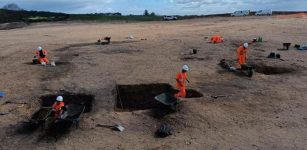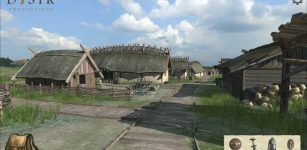8,000-Year-Old House Remains Discovered In Svinjarička Čuka, Serbia Raise Questions About Europe’s First Farmers
Jan Bartek - AncientPages.com - An extraordinary archaeological discovery in southern Serbia offers valuable insights into the early history of settlement in Europe. In Svinjarička Čuka, researchers have uncovered an 8,000-year-old house that provides crucial evidence about the development of early agricultural societies and the dissemination of Neolithic innovations throughout the Balkans.
The excavation sections after completion of the excavations in 2024 on the river terrace of Svinjarička Čuka, Serbia. Credit: M. Börner / ÖAI/ÖAW
This finding raises important questions about whether Europe's first farming communities were nomadic or settled seasonally. It also explores how sedentary lifestyles spread from Anatolia to Europe and how these initially settled communities influenced agricultural practices across the continent.
An Austro-Serbian team of archaeologists conducted the excavation under the leadership of the Austrian Academy of Sciences (ÖAW). They discovered remnants of a rectangular structure dating back approximately 8,000 years, offering a glimpse into early human habitation and societal organization in this region.
"The new finds in Svinjarička Čuka provide substantial insights and data, prompting changes to existing models for the development of settlements in the Balkans," says Barbara Horejs, archaeologist and academic Director of the Austrian Archaeological Institute of the Austrian ACADEMY of Sciences.
The site Svinjarička Čuka during the excavations in 2024. Credit: M. Börner / ÖAI/ÖAW
The partially collapsed and burned architectural elements covered overlapping floors inside the house and artifacts, tools, and scattered vessels in the presumed outdoor area. The various installations for storing food, grains, and seeds are particularly significant the researchers say.
According to Horejs, recent discoveries are challenging previous models that depicted the first European settlers as either nomadic or only seasonally sedentary. These earlier assumptions were based on widely dispersed pits thought to be remnants of lightweight huts. However, ongoing excavations at Svinjarička Čuka since 2018 have revealed several settlement phases from the Early and Middle Stone Age linked to the Starcevo culture. This culture is recognized as one of the oldest Neolithic communities in the Balkans and was pivotal in spreading agriculture from Anatolia into Europe.
The long rectangular burnt house with remains of built installations for food storage and numerous storage vessels in situ. Credit: M. Börner / ÖAI/ÖAW
The current findings also prompt new inquiries regarding these groups' geographic-cultural origins and their potential interactions with local hunters and gatherers, which are now under further investigation.
See also: More Archaeology News
To thoroughly analyze these findings, researchers employ microarchaeological methods such as examining sediments, botanical and zoological remains and conducting chemical analyses of soil samples. These techniques offer fresh insights into early house usage or human-animal coexistence that likely emerged with Neolithic developments around 8,000 years ago in Europe, according to Horejs.
Source: Academia Austríaca de las Ciencias (ÖAW)
Written by Jan Bartek - AncientPages.com Staff Writer























